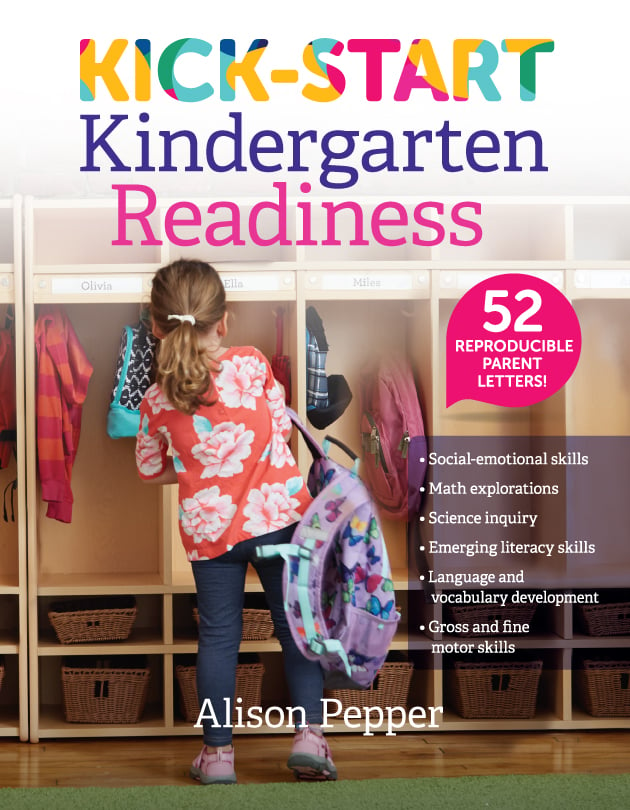- Home
- Activities
- Make Your Own Playdough | Downloadable Kindergarten Readiness Activity
Make Your Own Playdough | Downloadable Kindergarten Readiness Activity

Studies show that parent and family involvement with school is an important factor in children's later academic success. Many families of young children want to learn ways to support their young child in preparing for kindergarten. With 52 reproducible letters filled with simple, fun activities that families can do together at home, Kick-Start Kindergarten Readiness is a great resource for early educators wanting to give parents some activities to connect home to school.
Making play materials with children is a great way for families to be creative together. Playdough is one art materials that can easily be cooked in the kitchen with ingredients families likely have on hand. Try this terrific, long-lasting playdough recipe to support fine-motor, math, science, social-emotional, literacy, and language learning.
Make Your Own Playdough
Materials
- 2 cups flour
- 1/2 cup table salt
- 2 Tbsp. cream of tartar
- 2 Tbsp. vegetable oil
- 1 1/2 cups boiling water (adult only)
- Large bowl
- Food coloring (optional)
- Kitchen gloves (optional)
- Newspaper
- Aprons or old T-shirts
- Plastic containers with lids
What to Do
- If you plan on using food coloring, cover the counter with old newspapers to prevent the food coloring from staining. Put on aprons or old T-shirts to protect your clothing.
- Ask your child to pour the flour into a bowl, then let him or her add the table salt and cream of tartar and mix to combine.
- Ask your child to add the vegetable oil and combine.
- Adult only: Pour in the boiling water. Be very careful – this will be hot!
- Mix the ingredients until the dough forms, kneading a sit cools down.
- At this point, if you don’t want to add any food coloring, you’re finished!
- Place each color of playdough in a separate plastic container, and store them in the refrigerator. They will keep for months.
Tip: Use food coloring gel for really vibrant colors. Separate the playdough into equal parts, and roll the parts into balls. War gloves to avoid staining your hands. Poke a finger into each ball, and put a few drops fo food coloring into the space. Knead the dough to distribute the color evenly.
What Children Are Learning
Children will develop math skills by measuring ingredients, science skills as they observe how ingredients change when they are combined, and fine-motor skills as they mix the ingredients together. Children will learn new vocabulary such as mix, measure, soft, lumpy, hot, smooth, and color names.
What the Research Says
In the article “Playdough Power,” NAEYC recommends using playdough to support fine-motor, math, science, social-emotional, literacy, and language learning.
Exploring Playdough
Once you have made your homemade playdough, it’s time to play with it! Explore the playdough with you child, and see what he or she does with it. Your child might just wat to make long, rolled up strips or small balls and pile them up. Or your child might be interested in using some tools to work with the playdough. He or she might want to create something using twigs, straws, pebbles, or other items. Let your child explore!
Playdough feels nice in your hand and is very malleable. Ask your child how it feels in his or her hand, and search together for descriptive words such as squishy or mushy. Children can enjoy playing with playdough for a long time. Gauge your child’s interest by his or her engagement. It’s a great indoor or outdoor play-time activity and one that many children never tire of.
Materials
- Variety of household items such as a fork, dull knife, cookie cutters, rolling pin, jar lids, and so on.
- Variety of materials, such as twigs, chenille stems, pebbles, leaves, straws, and so on
- Newspaper or plastic tablecloth
What to Do
- Make the playdough.
- Cover a table or counter with the newspaper or a plastic cloth.
- Collect items to use with the playdough, such as lids from jars, cookie cutters, a rolling pin, a dull knife, and so on. Set everything out in an area where you child can easily access them.
- Encourage your child to explore the playdough. As he or she does, talk with your child about what he or she is doing.
What Your Child is Learning
You child will develop fine-motor coordination, the cognitive skills of creativity and curiosity, and new vocabulary. He or she will learn to experiment and problem solve.
What the Research Says
As children explore and manipulate playdough, they are building strength in all the tiny hand muscles and tendons, making them ready for pencil and scissor control later on. Poking and pulling objects made from dough strengthens hand muscles and coordination.